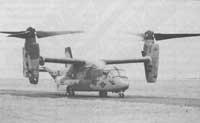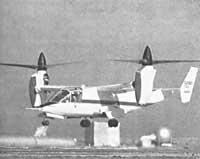Monorotor helicopter
1991/10/01 Otaolaurretxi, Jon Iturria: Elhuyar aldizkaria
The current normal helicopters have two rotors: one large and centered, and one smaller and located at the end of the tail. Due to the faults of the tail rotor, many accidents occur when the devices fall to the ground. The new helicopter model invented by McDonnell-Douglas has a single rotor. He removed the tail and replaced it with an air stream.
In the new prototype of McDonnell-Douglas Helicopter Corporation recently, the pilot circulates quieter than the other devices. The tail of the helicopter does not worry you and, unlike normal helicopters, passengers or any other danger can approach the tail of the apparatus due to the absence of rotor. Moreover, during the tests carried out, the pilot intentionally took the helicopter to the forest and introduced the tail between the trees. With other helicopters this manoeuvre (for its risk) is, of course, a mockery, but with this apparatus there is no fear that it is.
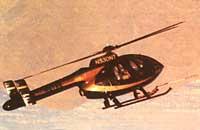
In conventional helicopters the tail rotor has two functions. On the one hand, you must balance the torque created by the large rotor. Otherwise, the rotation of the main rotor would cause the cab to start in the opposite direction. On the other hand, it serves to govern the direction of the helicopter. Without a tail motor, it would move directly and have no practical utility.
In all systems that have been invented to balance the torque, only two have triumphed: counteracting rotors and tail rotors. In the counteracting rotor, the helicopter has two horizontal rotors superimposed on the same axis, but to balance moments in the opposite direction (example: the Soviet model Kamov A-32). The two horizontal rotors can also be in different axes, one in front and one behind, turning in the opposite direction. These are banana shaped helicopters like the Boeing Vertol Chinook helicopter. In both cases, the timing of one rotor is balanced by the other and the cab and fuselage remain stable.
The second system is the tail rotor. It is certainly the most used and basically consists of placing a lower vertical rotor in the tail to balance the large central horizontal rotor. The tilt of the rotor arms may vary by cab pedals. However, this tail rotor has always raised concerns among manufacturers and pilots, among other safety issues.
In the 1970s, the French Aerospatiale house designed and manufactured a special rotor in the tail: a fairing rotor called fenestron. The rotor was protected by the fuselage and was better aerodynamic, but the tail was heavier. The weight problem has been partially attenuated by the recent appearance of composites. Whether the tail rotor or the fenestron system, driving conventional helicopters is a complicated task. In addition, even the tail must be transmitted the movement and the transmission parts in the helicopter beam have always been delicate and must be maintained very well.
In the McDonnell NOTE system (short for No Tail Rotor or no tail rotor), the air current of the main rotor is largely used to balance the torque. The downward air current hits the beam to the tail, where an adverse reaction occurs at the moment. The beams behave like the vertical vol-south.
Another part of the force needed to balance the moment is obtained with the current emitted by the fan driven by the motor. The beam up to Isatse presents at the end with adjustable windows on both sides and the reaction to the air outlet gives the missing part to balance the moment.
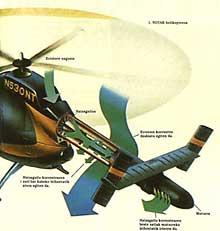
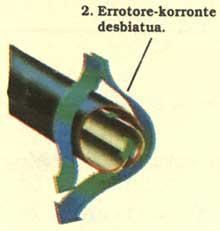
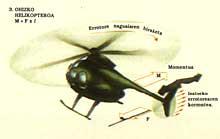
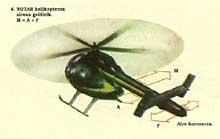
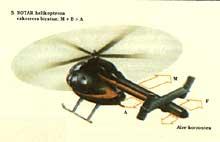
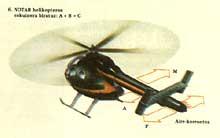
the tail rotor also serves to orient the helicopter. By increasing the inclination of the arms, the reaction force is greater than to compensate for the moment and the apparatus pivots to the left. Therefore, the helicopter goes right. If the tilt of the arms decreases, the helicopter moves to the left.
In NOTE helicopters, a fan connected to the engine sends an air current to the flow beam (Figure 1). Part of this current of air escapes through windows located in the center of the beam, low and right (Figures 1 and 2). This air asymmetrically diverts the current generated by the main rotor (due to the Coanda effect) and compensates 65% of the torque. The
other section of the air stream inside the beam continues to its end. At the end, several adjustable windows are opened and the pilot controls them to his taste. It therefore controls the direction and intensity of force B. To
keep the helicopter still in the air, the right extreme windows remain open (Figure 4) so that forces A and B compensate for the torque.
If you want to turn the helicopter to the left, the tail pivots to the right with the windows of the extreme left (Figure 5). If you want to turn left again, turn the tail to the left and open the windows on the right (Figure 6).
Another of the main headaches suffered by helicopters is the interaction of the controls. When a lever is activated, an action is carried out in the helicopter, but it affects all the actions in force and therefore the others must be compensated. However, compensation also affects other actions, which must also be compensated, etc.
For example, in the typical helicopter, let's think that the pilot has the device standing in the air and wants to move straight forward. The pilot acts on the lever tension and the main rotor tilts forward. This creates a horizontal force and propels the helicopter forward. But when the helicopter has tilted, the vertical force that the rotor exerts upwards is less to keep the apparatus in the air and would start downwards.
To avoid this problem, the pilot increases the tilt angle (angle of attack) of the rotor arms by carefully pulling another lever. With the tilted rotor arms it is necessary to send more fuel to the engine to maintain the rotational speed of the rotor. However, by increasing the engine power, the torque of the apparatus is also higher and the tilt of the tail rotor arms must also be modified to balance it.
According to pilots who have used NOTE helicopters for testing, the dynamic and aerodynamic interactions with the different axes of the apparatus are much smaller. Therefore, when a controller is operated, the pilot must use much less the other levers to compensate for interactions. It is a lever that does not govern the tail rotor or the windows leading the air stream.
The tests have also been carried out in large lateral wind gusts. In these conditions it is very difficult to maintain the direction in the usual helicopters, but the pilots of NOTA claim that with the new system the work goes down to a quarter in these difficult cases. In addition, you can take the helicopter off the ground, keep it resting out of the action of the ground and land it again slowly without touching other levers.
In the usual straight forward helicopter, the pilot must get the power of the tail rotor to the point of maintaining direction, but in the NOTE helicopter it is much easier.
When the tightening has to turn quickly in the helicopter, the tail has large swings in bat and the pilot cannot master more than 60º of spin per second. It must act on many levers to compensate for interactions in a very short time. In the new system, however, drivers have easily obtained turns of 100º per second.
It is also necessary to take into account the problems generated by the lateral wind. Conventional helicopters do not support side wind gusts faster than 20 knots (for example by standard OH-6A helicopter), but NOTE helicopters support gusts up to 40. Larger lateral winds are allowed in the military helicopter by placing a larger rotor in the tail, resulting in other headaches in weight and position, and the pilot should use the levers more. They are limited by the speed of manoeuvre, which is what military helicopters need.
NOTE devices allow faster maneuvers and have acrobatics capability. They can also go backwards and, although it may seem surprising, also upside down!
According to the military, the new McDonnell-Douglas helicopter is much safer for war. The rotor breakage in the tail by projection is very simple, so the device falls necessarily with its pilot. However, in the new system, even making a hole the size of the tennis ball in the tail beam, the apparatus would not fall.
The first device of the NOTE system has been the model called MD 530 N and is equipped with the Allison 250-C30 turbine. Since then, the MD 520 N has also been developed by installing the 259-C20R-2 turbine in Allison. In cabin and shape they are similar to those of the MD 500 helicopter series.

Gai honi buruzko eduki gehiago
Elhuyarrek garatutako teknologia




